Eric Haun
-
- Offshore Energy Outlook for 2020 Marine Technology, Sep 2019 #46
The “new normal” is a phrase tossed around often in offshore energy circles today as those servicing and operating in the sector grapple with the harsh realities of the prolonged industry downturn. Operators, service companies and equipment suppliers have been forced to adjust to oil selling at prices well below the $100+ per barrel mark seen in years past. As of this writing, Brent oil was hovering around $62 per barrel, and analysts expect prices will remain in this range for some time into the future.
On top of this, there’s another new reality for oil and gas companies to come to grips with: the so-called “energy transition”. Increasingly, more environmentally conscious governments, societies and investors are piling pressure on the industry and calling for emissions reductions and a shift toward renewable energy.
The industry has taken notice – and action. Oil and gas giants Shell and Equinor, for example, are taking part in developing renewables projects such as offshore wind farms. Claudio Descalzi, the CEO of Italian oil major Eni, said in October that he sees no future for firms focused solely on hydrocarbons.
In fact, many of the sector’s biggest names – from the super majors all the way through the supply chain – have committed to the energy transition.
This is good for the environment, but it’s also good business.
In the offshore wind sector, many, if not most, of the firms servicing the burgeoning market today have roots in oil and gas. Offshore services companies still hurting from oil’s downturn possess the expertise, skillset and technological capabilities aligned with those needed for offshore renewables work, opening the door toward new revenue streams that come with building a greener future. Offshore players such as Saipem, McDermott, Subsea7 and the soon-to-be demerged TechnipFMC, among others, while still heavily involved in oil and gas, have been winning renewables work for years. And their prospects are growing larger.
Europe, the offshore wind leader from the industry’s inception, continues to build capacity with a raft of new projects in various stages of development, while Asia and the U.S. are now developing huge markets of their own. The International Energy Agency (IEA) said in an October report that the offshore wind capacity may increase 15-fold and attract around $1 trillion of cumulative investment by 2040, spurred by falling costs, supportive government policies and technological advances such as larger turbines (e.g. GE’s 12MW Haliade-X turbine) and innovative floating foundations that are deployable in greater water depths where fixed turbines cannot be installed. And IEA believes the potential for growth is even larger with increased policy-maker support.
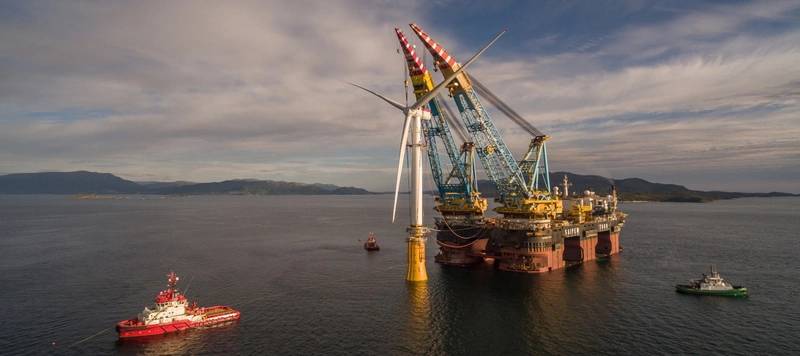 Italian services firm Saipem is among companies applying its offshore oil and gas expertise for renewables projects. (Photo: Saipem)
Italian services firm Saipem is among companies applying its offshore oil and gas expertise for renewables projects. (Photo: Saipem)Changing of the guard
While the prospects for renewables are bright, oil and gas still has a major role to play, both at present and into the future. Most analysts agree that demand for hydrocarbons will continue to grow over the next decade or two. This offers a great opportunity for oil and gas players to implement new technologies and low- or no-carbon solutions to be implemented in upstream operations. Importantly, the energy transition encompasses new methods and technologies that will increase efficiency and reduce or even eliminate emissions from hydrocarbon exploration and production. Oilfield services company Baker Hughes, for example, has committed to reducing CO2 equivalent emissions by 50% by 2030 and achieving net zero by 2050. As another example, the Seadrill-operated drilling rig West Mira has been equipped to run on batter power. The list goes on and on.The shift is undoubtedly a global one, but nowhere is it better showcased than in the North Sea. While those working in the region are already among the most experienced and technologically advanced in the world, a recent report from PwC and Oil & Gas UK finds that innovation and technology, collaboration between operators and the supply chain, and partnership models are crucial to the changing of the guard presently underway, especially as a number of new low carbon solutions continue to gain traction.
The report, Turning the Tide – the Transformation of the North Sea, published in November, says that fresh thinking and innovative solutions for driving performance are needed, especially after years focused on cutting costs. A supply chain that cannot sustain further tightening should focus instead on value over cost, the report suggests, though this will require operators and services firms to adjust their mindset.
Companies now believe it is critically important share their experiences of the deployment of new technologies, collaborate on developments and piloting, and engage more closely with the supply chain to reduce risk and the length of project timelines, the report found.
The PwC and Oil & Gas UK report also predicts an increased focus on technological and business model innovation to drive the next wave of competitiveness given operators and service companies have perhaps cut costs as far as is sustainably possible. New ideas, such as Equinor’s Hywind Tampen project, for instance, will help deliver the energy transition. In the Norwegian sector of the North Sea, the Hywind Tampen project will see 11 floating wind turbines deployed as to replace gas turbine power for the Snorre and Gullfaks oil and gas production facilities.
Other emissions cutting solutions such as electrification of production assets and unmanned platforms are also high on the agenda, including that of Norway’s largest oilfield services company Aker Solutions, who announced in October that it aims to generate half of its revenue from renewable energy and low-carbon technologies (such as carbon capture and storage, subsea gas compression, floating wind farms, electrification, etc) by 2030.
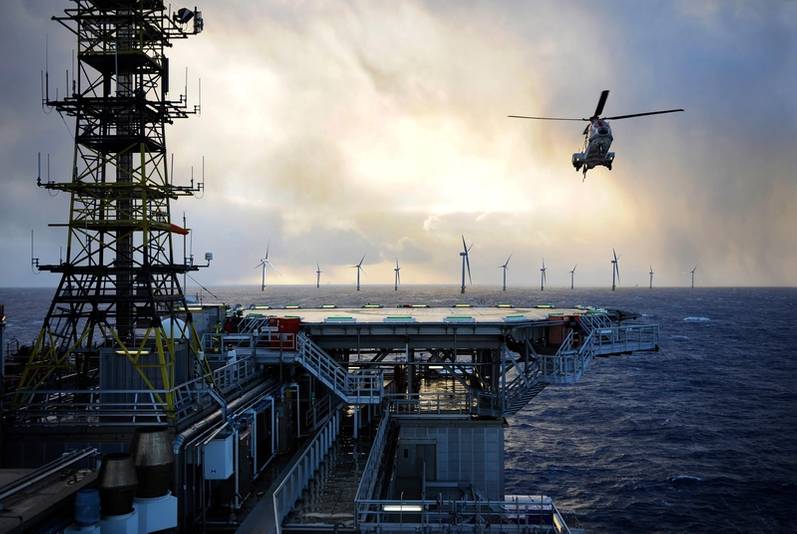 Equinor’s Hywind Tampen project will use floating wind turbines to provide power to the Snorre and Gullfaks oil and gas production facilities. (Image: Equinor)
Equinor’s Hywind Tampen project will use floating wind turbines to provide power to the Snorre and Gullfaks oil and gas production facilities. (Image: Equinor)A lot of hydrocarbons
In October 2019, the mega Johan Sverdrup field began production more than two months ahead of schedule and NOK 40 billion ($4.4 billion) below original estimates, thanks in part to innovative technologies and collaborative methods led by operator Equinor alongside partners Lundin, Total, Aker BP and Petoro.The largest development in Norway for three decades, the field is expected to produce for more than 50 years, tapping expected recoverable reserves of 2.7 billion barrels of oil equivalent. Once full field production is underway, Johan Sevrdrup will be able to produce up to 660,000 barrels of oil per day at peak. Simply put, that’s a lot of hydrocarbons. But, leveraging electricity power from shore, the field has record-low CO2 emissions below 1 kilogram per barrel – demonstrating the importance of technological innovation toward the energy transition, and how the oil industry still has work to do and an important role to play.
-
- C&C Building Towboat Trio for Hines Furlong Marine News, Feb 2020 #42
Hines Furlong Line currently has a trio of identical 6,000-horsepower towboats on order at C&C Marine and Repair in Belle Chasse, La.The timing is right to order the high-power newbuilds, said Kent Furlong, president and founder of Hines Furlong Line (HFL), citing the long-term implications of Subchapter M
-
- Better Blasting: Send in the Robots Marine News, Feb 2020 #50
When designing and constructing a new blast and paint facility at its yard in Belle Chasse, La., C&C Marine and Repair set out to create a safe, efficient and environmentally friendly worksite that would deliver a high-quality product.Fifteen months and 131 barges later, C&C Marine has nearly
-
- Tech File: Reliable Lifts Marine News, Mar 2020 #50
Patterson Manufacturing‘s new davit cranes are designed from the ground up for improved safety, ease of use, durability and reliability. What more could you ask?Patterson Manufacturing has supplied equipment into the marine market for more than 160 years, consistently expanding its lines of winches
-
- US Shipyards Forge Ahead Through COVID-19 Marine News, Apr 2020 #36
As the novel coronavirus and its impacts continue to spread across America, U.S. shipbuilders, by and large, continue to build. While most yards have been deemed essential to marine transportation and/or national security and have been able to maintain operations, the situation at and around every shipyard
-
- Profiles in Training: American Seafoods Marine News, Apr 2020 #40
more than 20 years and expanded to cover every aspect of the maritime world.Today, Camarena is Director of Training & Organizational Development for American Seafoods Company, a fishing company which runs six factory trawlers ranging from 256 to 341 feet. The company employs approximately 1,300 seafarers
-
- Autonomy on Trial Marine News, Apr 2020 #28
.Concept of operationsDomenic Carlucci, Director - Machinery, Propulsion, Electrical & Controls, Corporate Technology, at classification society the American Bureau of Shipping (ABS), says workboats and other smaller vessels that often ply shorter, dedicated routes are most ripe for autonomous operations
-
- US Barging Industry Navigating Black Swan Events Marine News, May 2020 #30
transport in particular, the impacts of these two black swan events vary greatly depending on the type of cargo being carried.David Grzebinski, CEO of the America’s largest tank barge operator, Kirby Corp., said in a March conference call that petrochemical customers have driven the market higher as plants
-
- Port of Indiana-Mt. Vernon Makes ‘Next Generation’ Terminal Upgrades Marine News, May 2020 #38
Port Director Phil Wilzbacher.Wilzbacher says the “megasite” is one of the largest green field industrial sites available at a public port in America’s heartland. “The area is well-suited for a steel production facility because of the direct waterway access to two U.S. coasts, five Class
-
- INSIGHTS: Mary Ann Bucci, Executive Director, Port of Pittsburgh Commission Marine News, May 2020 #12
Mary Ann Bucci has spent her entire career in many different aspects of the logistics profession, selling container space on international vessels for SeaLand Service, leasing railcar equipment for GE Railcar Services, and negotiated rail rate for Aristech Chemicals. Having spent the last 19 years advocating
-
- The Wing Group: Greater Than the Sum of Its Parts Marine News, Jun 2020 #20
to be a solution provider, became a gating metric that framed our view of acquisitions,” Branagh says.Wing had already established a strong North American market share building for customers such as the U.S. Army, Coast Guard, Navy and SEALS, even NOAA and NASA, among others, so it went oversees to reach
-
- Making the Case for Diesel Outboards Marine News, Jun 2020 #37
U.S. include Boatswain’s Locker on the West Coast, Texas Diesel Outboard, Innovative Diesel Technology and Ring Power splitting up the South and middle America, and Power Products in the Northeast.Both OXE and Cox diesel outboards are pricey compared to their gasoline equivalents, in some cases costing up
-
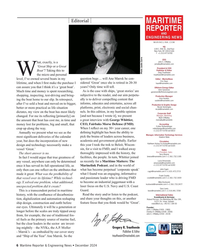 )
December 2024 - Maritime Reporter and Engineering News page: 6
)
December 2024 - Maritime Reporter and Engineering News page: 6.com Wthe micro and personal Editor - MarineNews level, I’ve owned several boats in my question begs ... will Ane Mærsk be con- Eric Haun lifetime, and when I ? rst make the purchase I sidered ‘Great’ once she is retired in 20-30 [email protected] can assure you that I think it’s
-
 )
November 2024 - Marine News page: 36
)
November 2024 - Marine News page: 36Feature Blount Boats Photo: Greg Trauthwein ‘IT’S IN OUR BLOOD!’ Left to right: Julie Blount and Marcia Blount Blount Boats Celebrates 75 Years By Eric Haun 36 | MN November 2024
-
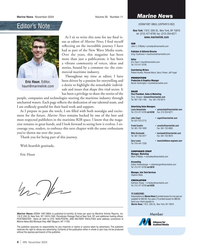 )
November 2024 - Marine News page: 4
)
November 2024 - Marine News page: 4Editorial Director Greg Trauthwein • [email protected] Over the years, this magazine has been more than just a publication; it has been Editor Eric Haun • [email protected] a vibrant community of voices, ideas and Tel: 212-477-6700 stories, bound by a common tie: the com- Contributing Writers mercial
-
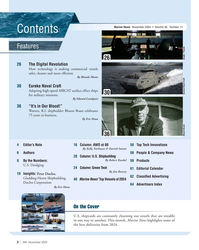 )
November 2024 - Marine News page: 2
)
November 2024 - Marine News page: 230 for military missions. By Edward Lundquist 36 “It’s in Our Blood!” Warren, R.I. shipbuilder Blount Boats celebrates 75 years in business. By Eric Haun Blount Boats Eureka Naval Craft Sergii / Pexels 36 4 Editor’s Note 16 Column: AWO at 80 50 Top Tech Innovations By Kelly Teichman & Patrick
-
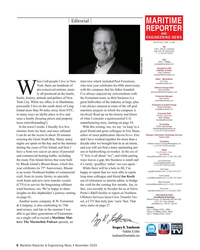 )
November 2024 - Maritime Reporter and Engineering News page: 6
)
November 2024 - Maritime Reporter and Engineering News page: 6C. O’Malley [email protected] President & COO Publisher & Editor Greg Trauthwein Photo Justin Zurre [email protected] Editor - MarineNews Eric Haun hen I tell people I live in New interview which included Paul Fernstrum, [email protected] York, there are hundreds of who next year celebrates
-
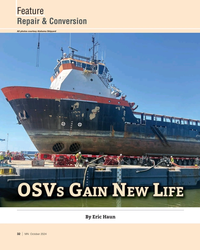 )
October 2024 - Marine News page: 32
)
October 2024 - Marine News page: 32Feature Repair & Conversion All photos courtesy Alabama Shipyard OSV G N LS AIN EW IFE By Eric Haun 32 | MN October 2024
-
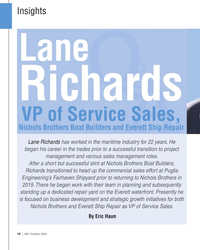 )
October 2024 - Marine News page: 10
)
October 2024 - Marine News page: 10he is focused on business development and strategic growth initiatives for both Nichols Brothers and Everett Ship Repair as VP of Service Sales. By Eric Haun 10 | MN October 202
-
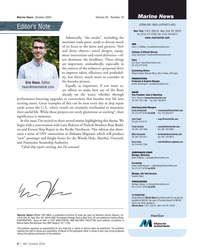 )
October 2024 - Marine News page: 4
)
October 2024 - Marine News page: 4Director Greg Trauthwein • [email protected] ment innovations and vessel deliveries—of- ten dominate the headlines. These things Editor Eric Haun • [email protected] are important, undoubtedly, especially in Tel: 212-477-6700 the context of the industry’s perpetual drive Contributing Writers to
-
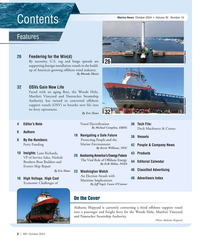 )
October 2024 - Marine News page: 2
)
October 2024 - Marine News page: 2Authority has turned to converted offshore support vessels (OSV) to breathe new life into its ferry operations. Alabama Shipyard Vineyard Wind 32 By Eric Haun 4 Editor’s Note Vessel Electri? cation 36 Tech File: By Michael Complita, EBDG Deck Machinery & Cranes 6 Authors 18
-
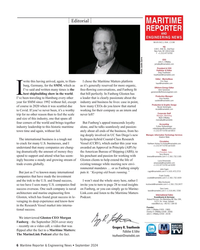 )
September 2024 - Maritime Reporter and Engineering News page: 6
)
September 2024 - Maritime Reporter and Engineering News page: 6C. O’Malley [email protected] President & COO Publisher & Editor Greg Trauthwein Photo Justin Zurre [email protected] Editor - MarineNews Eric Haun write this having arrived, again, to Ham- I chose the Maritime Matters platform [email protected] burg, Germany, for the SMM, which as as it’s
-
 )
August 2024 - Maritime Reporter and Engineering News page: 6
)
August 2024 - Maritime Reporter and Engineering News page: 6.com neering News, the latter outweighs the former]! A favorite part is traveling Amera was perfect for this month’s cover, Editor - MarineNews Eric Haun the world, visiting shipyards and large manu- with this ship’s original old engines com- [email protected] facturing plants, meeting people on
-
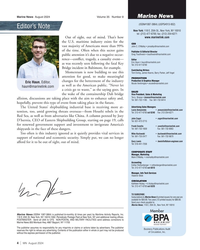 )
August 2024 - Marine News page: 4
)
August 2024 - Marine News page: 4Director Greg Trauthwein • [email protected] public attention it’s due to a negative occur- rence—con? ict, tragedy, a casualty event— Editor Eric Haun • [email protected] as was recently seen following the fatal Key Tel: 212-477-6700 Bridge incident in Baltimore, for example. Contributing Writers Mome
-
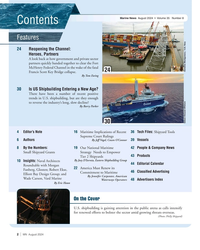 )
August 2024 - Marine News page: 2
)
August 2024 - Marine News page: 2Elliott Bay Design Group; and By Jennifer Carpenter, American Wade Carson, Vard Marine Waterways Operators 48 Advertisers Index By Eric Haun On the Cover U.S. shipbuilding is gaining attention in the public arena as calls intensify for renewed efforts to bolster the sector amid growing
-
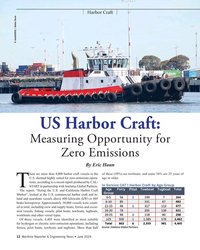 )
June 2024 - Maritime Reporter and Engineering News page: 12
)
June 2024 - Maritime Reporter and Engineering News page: 12Harbor Craft © sheilaf2002 / Adobe Stock US Harbor Craft: Measuring Opportunity for Zero Emissions By Eric Haun here are more than 4,000 harbor craft vessels in the of these (58%) are towboats, and some 56% are 25 years of U.S. deemed highly suited for zero-emissions opera- age or older. tions,
-
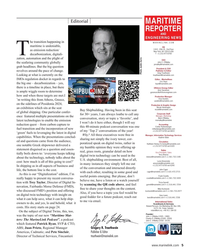 )
June 2024 - Maritime Reporter and Engineering News page: 5
)
June 2024 - Maritime Reporter and Engineering News page: 5Trauthwein Photo Justin Zurre [email protected] Looking at what is currently on the IMOs regulation docket in regards to Editor - MarineNews Eric Haun the big one – decarbonization – yes, [email protected] there is a timeline in place, but there Offshore Energy Editor Amir Garanovic is ample
-
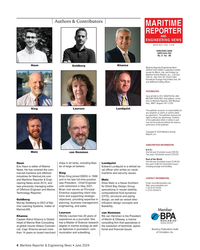 )
June 2024 - Maritime Reporter and Engineering News page: 4
)
June 2024 - Maritime Reporter and Engineering News page: 4(9 printed issues) $140.00; Haun ships in all ranks, including Mas- Lundquist two years $180.00 (18 printed issues) including postage and handling. Eric Haun is editor of Marine ter of large oil tankers. Edward Lundquist is a retired na- News. He has covered the com- val of? cer who writes on naval, mercial
-
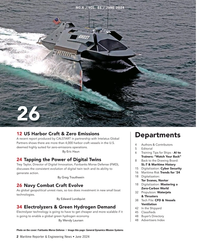 )
June 2024 - Maritime Reporter and Engineering News page: 2
)
June 2024 - Maritime Reporter and Engineering News page: 2there are more than 4,000 harbor craft vessels in the U.S. 4 Authors & Contributors deemed highly suited for zero-emissions operations. 5 Editorial By Eric Haun 6 Training Tips for Ships - AI to Trainers: “Watch Your Back” 24 Tapping the Power of Digital Twins 8 Back to the Drawing Board: Trey Taylor
-
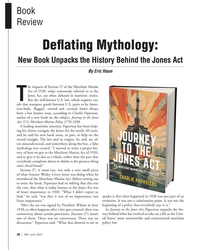 )
June 2024 - Marine News page: 38
)
June 2024 - Marine News page: 38Book Review De? ating Mythology: New Book Unpacks the History Behind the Jones Act By Eric Haun he impacts of Section 27 of the Merchant Marine Act of 1920, today commonly referred to as the Jones Act, are often debated in maritime circles. But the well-known U.S. law, which requires ves- T sels that
-
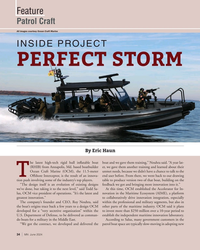 )
June 2024 - Marine News page: 34
)
June 2024 - Marine News page: 34Feature Patrol Craft All images courtesy Ocean Craft Marine INSIDE PROJECT PERFECT STORM By Eric Haun he latest high-tech rigid hull in? atable boat boat and we gave them training,” Nouhra said. “A year lat- (RHIB) from Annapolis, Md. based boatbuilder er, we gave them another training and learned
-
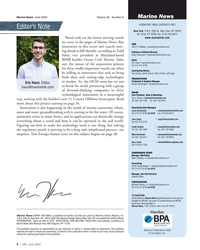 )
June 2024 - Marine News page: 4
)
June 2024 - Marine News page: 4& Editorial Director Greg Trauthwein • [email protected] Salus, vice president at Maryland-based RHIB builder Ocean Craft Marine. Salus Editor Eric Haun • [email protected] says the nature of the acquisition process Tel: 212-477-6700 for these vitally important vessels can often Contributing Writers be
-
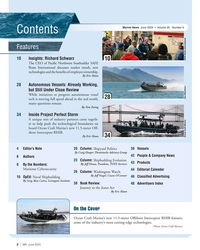 )
June 2024 - Marine News page: 2
)
June 2024 - Marine News page: 2CEO of Paci? c Northwest boatbuilder SAFE Boats International discusses market trends, new technologies and the bene? ts of employee ownership. By Eric Haun 28 Autonomous Vessels: Already Working, but Still Under Close Review While initiatives to progress autonomous vessel 28 tech is moving full
-
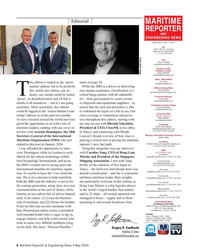 )
May 2024 - Maritime Reporter and Engineering News page: 6
)
May 2024 - Maritime Reporter and Engineering News page: 6C. O’Malley [email protected] President & COO Publisher & Editor Greg Trauthwein Photo Justin Zurre [email protected] Editor - MarineNews Eric Haun his edition is touted as the ‘green starts on page 28. [email protected] marine’ edition, but to be perfectly While the IMO is a driver on delivering
-
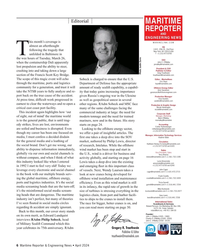 )
April 2024 - Maritime Reporter and Engineering News page: 6
)
April 2024 - Maritime Reporter and Engineering News page: 6.com section of the Francis Scott Key Bridge. The scope of this tragic event will echo Sobeck is charged to ensure that the U.S. Editor - MarineNews Eric Haun through the maritime, ports and logistics Department of Defense has the appropriate [email protected] community for a generation, and trust
-
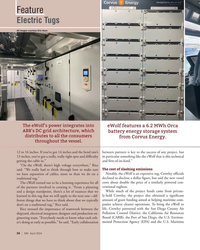 )
April 2024 - Marine News page: 34
)
April 2024 - Marine News page: 34Feature Electric Tugs All images courtesy Eric Haun The eWolf’s power integrates into eWolf features a 6.2 MWh Orca ABB’s DC grid architecture, which battery energy storage system distributes to all the consumers from Corvus Energy. throughout the vessel. 12 to 16 inches. If you’ve got 14 inches and
